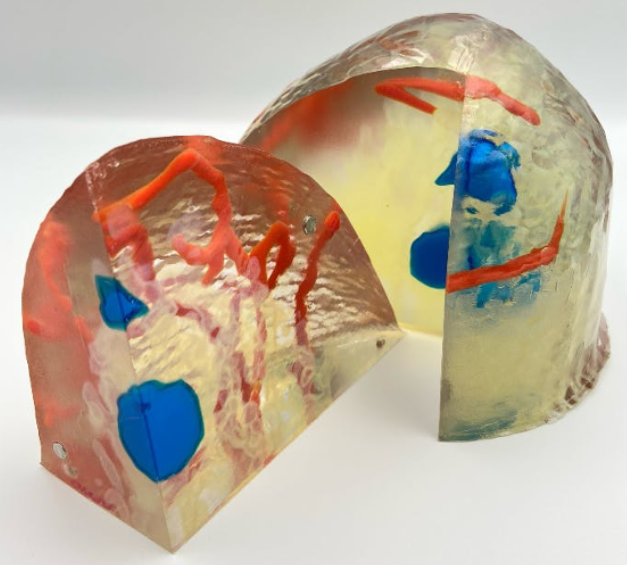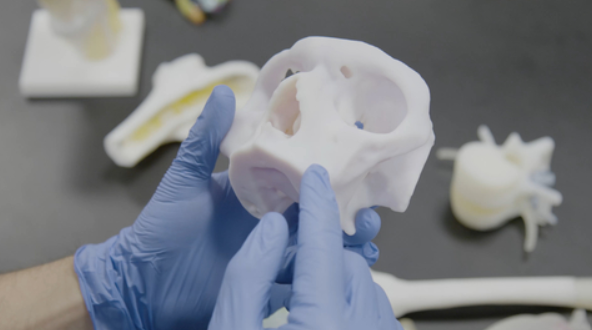Join the Expert Committee for the 2024 3D Printing Industry Awards to help select the winners!
3D printer OEM Stratasys and Ricoh USA have enrolled the first patient in a clinical study on 3D printed models for orthopedic oncology.
This study compares the efficacy of patient-specific 3D printed models against traditional CT or MRI imaging for preoperative orthopedic oncology planning and tumor excision. Involving up to 150 patients across three sites, this prospective, multi-center randomized controlled trial will span 12 months. Participation has been confirmed by The Ohio State University Wexner Medical Center and Corewell Health in Michigan.
Gary Turner, Managing Director, Additive Manufacturing, Ricoh USA, said, “We are thrilled to co-sponsor this important clinical trial alongside our longstanding partners at Stratasys to further demonstrate the potential impact of 3D patient-specific modeling as well as accelerate adoption of this technology to better serve a broader population.”

Improved surgical precision with 3D models
3D printed models significantly enhance preoperative planning by providing life-size, physical replicas of patient anatomy. This allows surgeons to practice and refine complex procedures more efficiently, improving accuracy and reducing the risk of incomplete tumor removal. The result is better surgical outcomes, improved patient recovery, and more effective communication of planned procedures.
As per Stratasys, this joint research project seeks to improve surgical outcomes by evaluating two different methods for tumor excision. In the experimental group, surgeons will use 3D printed models of the tumors in addition to standard imaging for preoperative planning. In contrast, the active comparator group will rely solely on imaging techniques.
The study will compare results between these two approaches, focusing on factors such as reduced blood loss, shorter duration of surgery and anesthesia, and fewer procedural complications. By analyzing these outcomes, the research aims to determine if the integration of 3D printed models can lead to better surgical results.
“Being one of the sites to participate in this study puts us on the forefront of demonstrating new technologies that can advance patient care and improve health outcomes,” said Aws Hammad, M.D., Clinical Faculty Of Orthopedic Surgery at Corewell Health William Beaumont University Hospital. “Addressing the challenges that come along with bone sarcomas and utilizing the power of patient-specific 3D modeling is a significant step in not only patient education but as an aid to surgeons for more precise surgical procedures.”
Last year, Stratasys and Ricoh partnered to provide on-demand 3D printed anatomic models for clinical use. By combining Stratasys’ 3D printing technology, Axial3D’s AI-driven segmentation, and Ricoh’s precision manufacturing, the team created realistic models to aid surgical planning and improve patient communication. This collaboration offered a cost-effective solution, eliminating the need for healthcare facilities to invest in 3D printing equipment.

Cancer recovery leveraging 3D printing
As observed previously, 3D printing is increasingly used in cancer treatment. By creating highly detailed patient-specific models, surgeons can enhance surgical planning, execution, and potentially improve patient outcomes.
One breakthrough case that was reported in 2022 included a 50-year-old Bangladeshi man who underwent a complex surgical procedure at Manipal Hospitals, India, to remove a rare cancer affecting his sternum and ribs. Surgeons removed the tumor and the damaged skeletal structures, replacing them with a custom 3D printed titanium implant.
Designed with honeycomb technology to reduce weight, this implant enabled the patient to breathe normally without mechanical ventilation. Highlighting the potential of modern technology, the surgery offered a solution to a previously incurable condition. Post-surgery, the patient experienced a smooth recovery, with enhanced functionality and fewer complications.
Clinicians at Claudius Regaud Institute and Toulouse University Hospital performed a nose transplant on a patient who had lost most of her nose to cancer in 2013. Following several unsuccessful reconstructions, the patient agreed to a new method involving a 3D bioprinted nose grown on her forearm.
The implant was nurtured on her skin for two months before being revascularized and successfully transplanted onto her face. Using CERHUM’s MyBone technology, this procedure marked a first in facial transplantation and showed favorable recovery outcomes.
What 3D printing trends do the industry leaders anticipate this year?
What does the Future of 3D printing hold for the next 10 years?
To stay up to date with the latest 3D printing news, don’t forget to subscribe to the 3D Printing Industry newsletter or follow us on Twitter, or like our page on Facebook.
While you’re here, why not subscribe to our Youtube channel? Featuring discussion, debriefs, video shorts, and webinar replays.
Featured image shows 3D printed anatomical model from Ricoh. Image via Ricoh.



